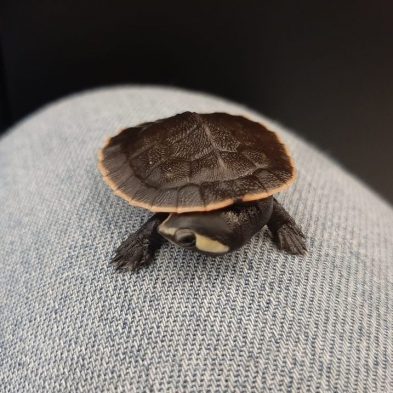
Description:
Emydura subglobosa can grow up to 10″ and have a grey/olive green face with a yellow mask that extends to both sides of their face. Their shell is a flat dark brown color with a pale-yellow ring around the edge. The underside is where the pink will start to show as the turtle grows older. You will also find pink underneath the chin of the turtle. Pink belly Turtles, like most aquatic turtles, have the webbed feet for easy swimming, as well as foraging at the bottom of the enclosure for food.
Like most reptiles there is always a risk for salmonella. Turtles should not be handled unless necessary or in very small amounts. Remember to wash hands before and after handling to ensure the safety of both yourself and your pet.
Native Range:
Emydura subglobosa is originally found in Papua New Guinea and Australia however the Pink Belly Turtles at Aquariums West are all born and raised in Canada.
Life Span:
Turtles will live a long time and Pink Bellies are no exception, living for at least 30 years in captivity, but can easily live past 50.
Diet:
An interesting fact about aquatic turtles is they cannot swallow their food above the water, while they may take bites from above, they won’t swallow until submerged. Pink Bellies have a diverse appetite and will readily take most things given to them. Note that younger turtles will require a higher source of protein as this will help them grow. In captivity it is good to give them a variety of food such as:
High Grade Pellet Food:
Pellet food should not be the main source of food you feed your turtle, but a high-grade pellet can be a good supplement from time to time.
Live food:
Live food is great for your turtle because it can give them something to do as well as provide great nutrients. Feeder insects and fish are great for your turtle.
Fruits and Vegetable:
As your turtle gets older it will start to eat more fruits and vegetables than when it was younger. Some good veggies to feed your turtle include collard greens, kale, zucchini, butternut squash, as well as shredded carrots. For fruits consider thin sliced apples and melons, cut up strawberries, raspberries and bananas.
Remember to supplement food with a multi vitamin powder, as well as a calcium D3 powder.
Housing:
While a juvenile pink belly can be housed temporarily in a 30 gallon, it is best to keep in mind that the small turtle you are picking up from the pet store will grow and you’ll soon find that it has outgrown its tank. It will take your pink belly between 8 to 10 years to reach its full length of about 10 inches, when your pink belly is full grown, a tank size of 75 gallons or larger is required to keep them healthy and happy.
An appropriately sized filter will be needed to keep your turtles home clean. Turtles are very dirty creatures and we recommend getting a filter that is calibrated for a larger aquarium. This will allow you a bit more lenience with cleaning the filter. Water changes should be done weekly to ensure the best water quality.
While your turtle is mostly aquatic it will need a dock to climb onto to dry off and bask. Make sure the dock is large enough for your turtle to be able to turn around completely. The dock should have a ramp that reaches a few inches into the water to make it easier for your turtle to climb up. Decorations will enhance the look of your tank as well as create a stimulating environment for your turtle to live in. Natural rocks, driftwood, artificial or real plants are great for the tank. It will also create hiding spots for your turtle to feel safe in.
Temperature and Lighting:
Water temperatures should be maintained between 24 – 84C (75 – 85F). Use an aquarium heater in a protective plastic case. We recommend the Fluval E series of heaters which are suitable for the rough and tumble of a turtle. Turtles can break the glass of a heater and suffer the consequences of electricity and water!
There are three types of light that you will need for your pink belly. UVA and UVB are the first two types you will need; these are important to help your turtle absorb vitamins and nutrients. Most bulbs contain UVA, but you’ll need to also get a bulb with UVB in it. UVB bulbs should be replaced every six months even if the bulb itself hasn’t burnt out yet.
You will also want a basking bulb where the temperature above the water reaches 90 to 95 degrees Fahrenheit, make sure to get the right size wattage of bulb, since bigger tanks will require a higher wattage of reptile bulb. You might want a bulb that is splash proof since it may encounter the water from time to time, depending on how active your turtle is.
Place all bulbs in the direction of your turtles docking area. The basking bulb should be right above, whereas the UVA/UVB bulb can cover the entire tank, as well as the dock area.
While pink belly turtles can be very rewarding pets, it is important to remember these are long living, high maintenance animals, who do not do well in small tanks. Careful research should be made before purchasing a pink belly turtle.
Useful Products:
- 40 Gal tank (to start)
- Fluval 307 canister filter
- Fluval E Series Heater
- Zoo Med turtle Dock
- Zoo Med Reptisun LED UVB terrarium hood
- Exo Terra Swamp Basking Spot Bulb
- Deep Dome Lamp Fixture

